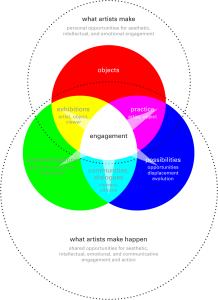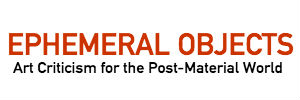I really love this illustration by Christine Wong Yap diagramming “What Artists Make Happen”.
My only major bone of contention is her assertion that, “Artists make objects. The very activity of manipulating materials with an openness to their possibilities is the development of our own practices” and that “…artists make exhibitions, which are events/situations for engagement between the artist and viewer via the object.”

The central argument I’m proposing with the Ephemeral Objects blog is that our understanding of what artists do need not be limited to the creation of material objects. By extension, the creation of non-material objects is an art form unto itself that crosses multiple disciplines – music, theater, dance, media, film, performance, digital, etc. – and that these artistic disciplines require skill, craft and expertise; they have their own particular knowledge bases, theories and contexts. If artists are using expanded practices to include the creation of non-material objects, then they must learn those skills and gain expertise or collaborate with artists who have them. It is irresponsible for artists working in the creation of material objects to transition to non-material objects without learning the existing knowledge bases, theories, contexts and concerns of artists working in ephemeral or embodied practices.
Similarly, critical engagement with non-material objects demands an expanded field of practice around discourse. It is not enough to merely create the appearance of rigor, either within the work or in the discourse; it is necessary for artist and critic alike to understand the realm of the non-material, its conditions and concerns, to truly make great works for art and write about them thoughtfully.

Andy, thanks for engaging with my ideas, and the diagram I developed in an attempt to elucidate my thoughts.
A point of clarification: I used “make” to talk about physical objects or spaces, and “make happen” to discuss more immaterial states or spaces (perhaps that’s what you might call the “non-material object”). Indeed, my narrative is written beginning in the “what artists make” sphere, with the object-oriented artist, and then I continued into the “what artists make happen” sphere, where I situated non-object practices: “Artists also make events/situations (which are not object-based exhibitions) happen. These are spaces—physical or psychological—for attention or interaction. Participatory projects, public interventions, and of course, happenings, are some examples.”
I can’t help but notice how my post—which is speculative—is used to spur a riposte which reads to me argumentative and oppositional, with intimations of immorality (“irresponsible” behavior; the counter-example of “creat(ing) the appearance of rigor”).
I agree that it would behoove artists to learn about “existing knowledge bases, theories, contexts and concerns” of other fields or expanded realms of art practice. But I wouldn’t go so far as to mandate it, as your post seems to suggest (if my reading is accurate?). In other words, are experiments or speculative exercises unwelcome unless one has achieved a certain level of mastery? If so, to whose satisfaction?
Hi Christine,
My response *is* argumentative and oppositional – but it is not hostile.
I believe that there is a very fundamental difference between the artistic practice of making objects and the practice of making non-object art.
My aesthetic position opposes the cultural hegemony of existing power structures in the visual arts. Dominant aesthetic frameworks created and enforced by elite museums and MFA programs reject craft and skill, privileging the conceptual – particularly as related to “expanded practice”.
But I propose that dilettantism is not art practice and the aesthetic of “de-skilling” is, in fact, a devaluation of labor more consistent with the values of the ruthless neoliberal late capitalism driving the art market than a legitimate artistic position.
The fact that I am a gifted text-based artist would not lend credence to my entirely untrained and unskilled attempts at sculpture or painting. Music, dance, theater, community-based arts (currently being gentrified as “socially engaged art”) – not to neglect film, video and software/media art – certainly welcome “experiments and speculative exercises”, but each form has a history, aesthetic considerations and skill sets associated with it that artists spend years to master.
When you say, “If so, to whose satisfaction?” you seem to be implying that artists positioning themselves in the visual arts context are performing some kind of resistance to power by expanding their practice into forms of which they have little knowledge and in which they are not trained.
In fact, this position is an assertion of the privilege imbued by complicity in a market-driven power structure. If artists, by virtue of participation in that system, by receiving an MFA and the approbation of that system and accepting the unquestioned assumptions of that system’s aesthetic frameworks, expand their practice while disregarding the skills, craft and training of their fellow artists, they undermine their own real value and that of their non-object-making peers.
What if the answer to your question was, “To the satisfaction of your peer artists who have spent years training and perfecting their craft?” Would you respect your peer artists enough to want to learn more about the forms they have dedicated their lives to mastering?
I have written numerous essays about this on my other website Culturebot.org, one of which was recently published in the “Live Art Almanac: Vol. 3”
http://oberonbooks.com/live-art
And if you’re in NYC I will be lecturing on this – and other related ideas – at NYU on June 2.
http://www.culturebot.org/2014/04/21749/five-lectures-on-live-performance/
Andy,
I have trouble seeing why/how Christine’s work relates to your argument here… When she discusses artists that make things happen – she is talking about a very different kind of practice than those art forms that you list as examples of non material art making.
I don’t really want to get into a whole conversation about de-skilling here, though one could argue that what you describe as mastery, training, entitlement to participate in certain forms, etc., is itself a reflection of capitalist hegemony that serves to dictate how such forms should be approached and to maintain their elite status and marketability. Don’t the same institutions you critique enforce this very notion of mastery?
You seem to assume that interdisciplinary artists are not approaching these other forms with respect to “their own particular knowledge bases, theories and contexts” – and maybe that’s true sometimes – but it seems rather sweeping. Additionally, often, the reasoning for engaging with those other practices and utilizing elements of those forms may be very different from the more traditional approach to the forms themselves, so being highly skilled in those forms may often be quite irrelevant to the point of an artistic endeavor.
Approaching things with respect to their “their own particular knowledge bases, theories and contexts” is great if that’s what interests an artist to do or if it would indeed better serve their project. But, I have a negative reaction to your use of the term irresponsible in describing artists who veer into non material practices because I see it as anti-democratic and limiting to expression. But, more to the point, I disagree with the limited way you define what constitutes such non material practices in the arts (music, theater, dance, etc).
There are myriad ways that artists are creating non object based works that emphasize the ephemeral and immaterial that don’t involve any such established practices – just take some examples from Christine’s Make Things Happen – in which projects invite intrapersonal exchanges and participatory, collaborative, experiences. Is there some offense to an already established artistic discipline in inviting participants in a project to , for example, “explore looking as a form of time travel”?
Whether I agree with some of your overarching arguments or not, I don’t see Christine’s diagram as a relevant starting point for your points, especially in so far as her ideas are elaborated here:
http://blog.christinewongyap.com/2013/02/09/what-artists-make-happen/
Personally, I find her ideas inspiring, thoughtful and layered – I appreciate the emphasis on possibilities and engagement, creating dialogues and communities, which can take many forms.
~ Suzanne
Hi Suzanne –
Her post was not the jumping off point for my whole post. I said I liked Christine’s drawing I just disagree with her about objects. In fact, the reason I linked to her drawing at all was because I thought it was particularly resonant with the idea I proposed in this video:
about expanding the frame of engagement with ephemeral work.
I hope you’ll take 13 minutes to check it out and see what I’m talking about.
thanks
Andy